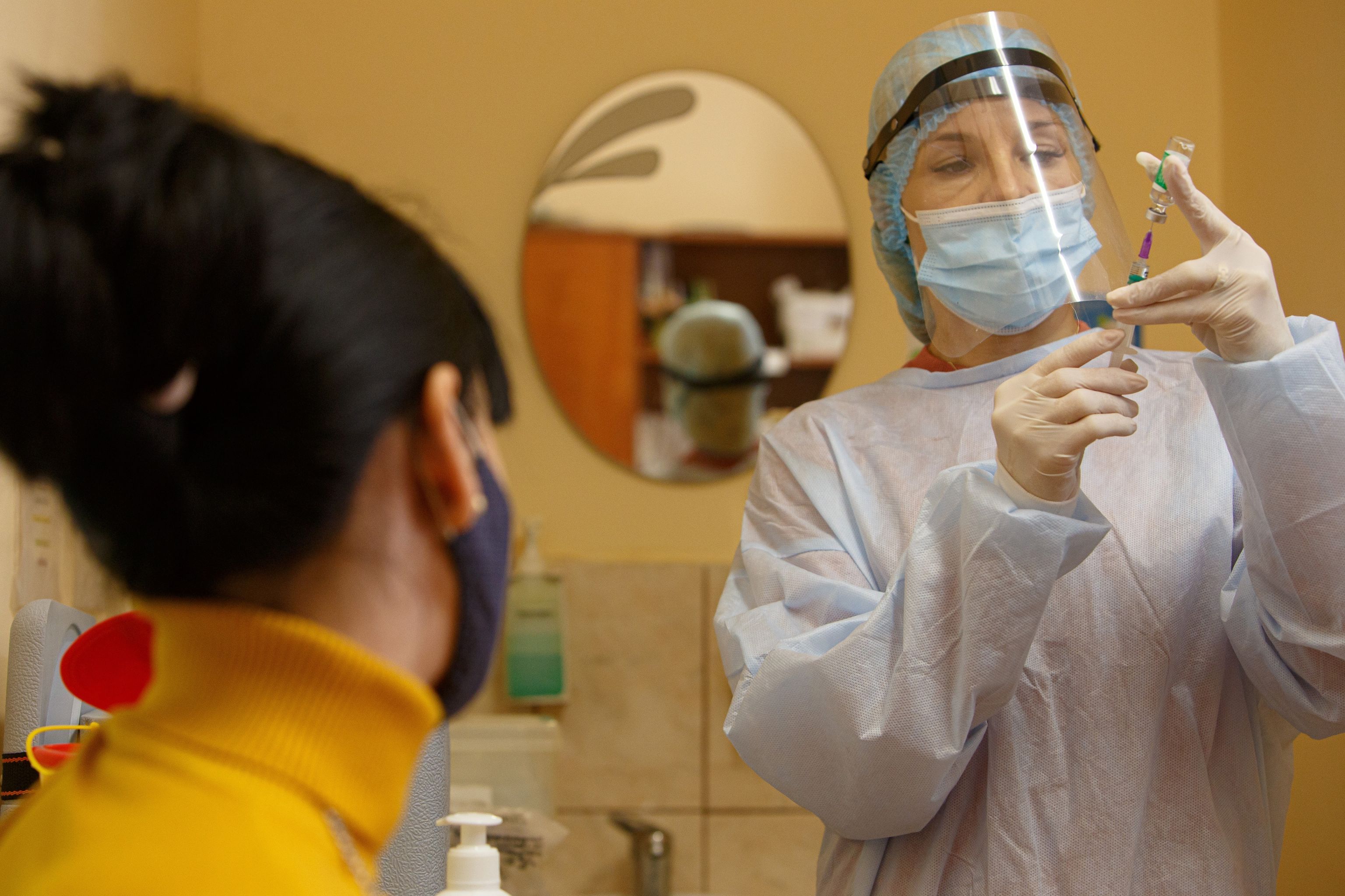Late Start and a Slow Pace: Vaccinations Against COVID-19 in Ukraine

Sources of Vaccine Supply
Ukraine has so far managed to contract a total of about 27 million doses of vaccine, which will allow about 33% of the population to be vaccinated. The first delivery of 500,000 doses of Covishield (AstraZeneca) was delivered on 23 February from India, which is currently the main source of vaccines for Ukraine. The Serum Institute of India will supply a total of 17 million doses of the AstraZeneca and Novavax vaccines it produces under license. The contract was made possible through the mediation of Crown Agents, a British company dealing with, among others, the support of health services in developing countries. The company has experience in cooperation with Ukraine.
Under the World Health Organisation’s COVAX programme, Ukraine will receive 8 million doses of vaccine. However, the delivery schedule is unknown due to delays by manufacturers. One of the largest donors to this programme is the European Commission, which allocated €500 million for COVAX under the Team Europe (TE) mechanism. The next step in the assistance provided by TE is to allocate 5% of the 2.3 billion vaccine pool reserved for EU countries to partner countries. For priority treatment of the Eastern Partnership countries, 13 EU states, including Poland, appealed in a letter to the European Commission on 6 January this year. Polish authorities have also offered to resell 1.2 million vaccines to Ukraine. However, it is still unclear when the products will be transferred, especially given problems with the delivery of subsequent batches of vaccines to the EU countries themselves by manufacturers.
Ukraine also has signed a contract for the supply of 1.9 million doses of the Chinese Coronavac produced by Sinovac. However, the Ukrainian importer Lekchim reported on 9 February that the procedure for obtaining a license from the Chinese government was delayed. This may be the PRC’s response to sanctions introduced by President Zelensky on 28 January against the Chinese company Skyrizon involving the purchase of Ukrainian company Motor Sich. An investigation launched by the National Anti-Corruption Bureau of Ukraine may also have a negative impact on the implementation of a state contract with Sinovac. The investigation is looking into whether the Ukrainian minister of health misused his power when selecting a supply broker by supporting Lekchim in the procedure. He authorised purchases of the Sinovac vaccine for $17.85 per dose although it is estimated to cost around $3.
Despite talks with the U.S. since May last year, Ukraine cannot count on a supply of vaccines from that country for now. President Joe Biden’s priority is to control the pandemic in the U.S. and therefore will not deliver doses to its foreign partners. However, the U.S. will assist Ukraine with the transportation and distribution of Pfizer-BioNTech vaccines that require ultra-cold storage temperatures, a small number of which Ukraine will receive under the COVAX programme. USAID is coordinating this support.
Ukrainian authorities are against the purchase of the Russian Sputnik V vaccine. The Ministry of Health of Ukraine (MHU) expresses doubts about its safety and is not considering registering it. However, the decisive factor is that the Ukrainian government will not import a vaccine from a country with which Ukraine is engaged in a military conflict. Russia, in turn, delivered the first batch of Sputnik V doses to occupied Donbas on 1 February, using it for propaganda purposes. Russia is trying to present Ukraine as a state incapable of providing vaccines to its citizens, and the EU and U.S. as states unable to help their partners in the region.
Implementation of Vaccinations
The Ukrainian vaccination programme, originally approved in December last year, has already been adjusted several times to the changing situation with supplies. The Ukrainian authorities have also made various, often contradictory, declarations as to the dates of administration of the vaccine and groups of people who will be able to receive it as a priority. According to the current iteration, 50% of the population should be vaccinated by the end of 2022, so about 20 million people, in four stages. The first is to cover 367,000 people most at risk of infection: healthcare workers caring for COVID-19 patients, people who live in long-term care and support facilities, employees of those institutions, as well as soldiers serving in the war zone. The next stages are to include, among others, medics and soldiers, teachers, and the elderly. Vaccinations are to be carried out both through health centres and mobile points.
Vaccinations began on 24 February. During the first week, fewer than 5,000 people received the vaccine (about 10 times less than during the first week in Poland). The main obstacle to the rapid implementation of vaccinations, apart from the expected delays on the part of the manufacturers, are a lack of infrastructure, which hampers the logistics of vaccine distribution and storage. The refrigeration equipment owned by Ukraine requires modernisation, for example, sufficient apparatus for monitoring the temperature of the preparations, and there are problems with the supply and disposal of special injection equipment. Moreover, Ukraine does not have equipment that would allow the storage of vaccines that require temperatures below -20° C (e.g., Pfizer-BioNTech).
Another challenge is that in a recent survey only 43% of Ukrainians are willing to be vaccinated, even free of charge, and this figure is gradually falling—in November, 55% of Ukrainians wanted to be vaccinated. Medical staff are also sceptical of vaccinations, and only a small number of people register for the vaccinations, explaining it as a lack of trust in the preparation produced in India (although under a British license). Overall, less than 4% of Ukrainians trust the vaccines from India. As a result, on the first day of online and telephone registration, launched on 1 March, only 45,000 people expressed their willingness to be vaccinated (in Poland, a similar opportunity was used by 1.1 million people within 24 hours). The slow vaccination process is also influenced by the low approval of Ukrainians for the government’s actions against the pandemic. More than 22% of Ukrainians are concerned that the vaccines may not be properly handled by the healthcare system, resulting in poor condition doses being administered.
Perspectives and Recommendations
By the end of the year, Ukraine will probably be able to vaccinate only those most at risk of becoming infected or those at risk of suffering from the severest course of COVID-19 (e.g., the elderly and those with pre-existing conditions). This will reduce the burden on hospitals but will not provide vaccine-based herd immunity. Ukraine has been late in contracting vaccine supplies, stretching delivery schedules. In turn, logistical constraints and low public confidence in vaccinations will further slow the process after the delivery of the preparations.
The slow pace of vaccination in Ukraine will force the authorities to introduce further restrictions in response to spikes in morbidity. These, in turn, will prolong the economic recession in Ukraine and lower support for President Zelensky and the ruling Servant of the People party. Pro-Russia groups that criticise the Ukrainian authorities for their ineptitude and for foregoing the Russian vaccine may benefit from this.
Poland can support Ukraine by offering medical personnel training, distribution logistics, and storage of vaccines, as well as pushing the EU to launch a support programme in Eastern Partnership countries like the Team Europe mechanism in 2021. This would accelerate the delivery of vaccinations in these countries and improve their ability to distribute larger batches of preparations. The EU should also consider prioritising the Eastern Partnership countries by making deliveries from potential surpluses under the TE mechanism. This would protect these countries from delays in vaccination due to the high risk of untimely deliveries from manufacturers. These actions would improve both the pandemic and economic situations, reduce the effectiveness of Russian propaganda, and have a positive impact on the EU’s image in Ukraine.



